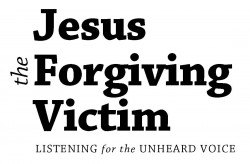Now that we have completed the three imaginative exercises around Atonement has your explanation of what is going on in this image and what it means to say that Christ died for our sins changed? If so, how.
My understanding of Atonement has changed radically as a result of the three imaginative exercises. Recently I attended an online conference on racial justice at my church. Now when I look at Jesus on the cross in the altarpiece, I see Michael Brown, killed August 9, 2014, by police in Ferguson, Missouri. http://bit.ly/1TuUL7R
I don’t mean to say that Michael Brown’s life was equivalent to that of Jesus’s life and teaching. As far as I know, Michael Brown was no prophetic sage. No. What I see in the altarpiece is Jesus occupying the place of the ‘social other’ victim. Michael Brown in many ways leading up to and including his death also lived in the place of ‘social other’ victim. We create this brutal place of the ‘social other’ victim by telling ourselves who we are in saying who we are not.
Now God is always coming toward us cloaked in the gold-flecked robe of the High Priest in the first temple Atonement liturgy or present with David and the Gibeonites bargaining over the fate of Saul’s sons. (This moment of Atonement is one I need to go back and review. I’m not sure I get it.) And then, God returns as did Fernando saying He always loves us. Even as we mistreated him, Fernando loved us. God’s atoning presence is personally immediate as God continually returns to the places of our iniquities.
I’m finding that the personal immediacy of Atonement shatters the ‘social other’ sense of who I am in an antifragile breaking apart. In 2012, Nassim Taleb published his book ‘Antifragile: Things that gain from disorder.’ Crystal vases are fragile. Drop one on a concrete floor and there’s no returning it to wholeness. But the athlete who loses a contest shattering all her hopes can get up again to practice harder to win the next time around. That’s antifragile.
God shattered God’s self as the Lamb in the place of the ‘social other’ victim. But, the Lamb, who is antifragile, returns to reveal our true identity. The Risen-Christ shatters the prisms of our ‘social other’ lives and then reintegrates the Light that was captured and broken apart by those prisms. Gods want to pray us into new life through intimate relationship. As we listen and obey God, the ‘Other other’, we discover our true identities in God’s eternal and Antifragile presence.
